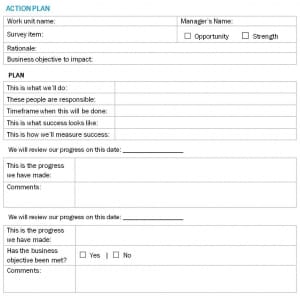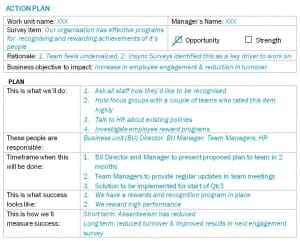

Action planning post employee survey
| It’s important to follow through on promises after an employee engagement survey to show your commitment to improving your organisation. It also shows that you value your employees’ feedback; that they are being heard and that they will see improvements as a result.
Action planning turns your employee survey results into practical and manageable steps. |
The action planning process
1. Discuss
Encourage comments and discussion from all team members by asking open-ended questions.
2. Prioritise
Decide with your team what is most important to address from the employee survey. Focus on matters that you as a manager can influence.
3. Plan
Decide what will be done, by whom and by when.
4. Review
Improvement is a journey, not an event. Review and follow up to ensure people are completing their tasks which, in turn, should result in actual improvements in the next employee engagement survey results.
Example agenda you may wish to use:
| AGENDA
Meeting focus: Our employee engagement survey results and next steps 1. Welcome
4. Next steps: action planning |
Discussion: our employee engagement survey results
Generate discussion among your team focusing on the engagement driver items of your employee engagement survey that are important to your organisation.
Ask your team:
- Do the results on any particular item surprise you?
- Are the results on a particular item reflective of how you feel now as a team?
- What were you thinking about when you answered this item?
- What would a rating of 7 “strongly agree” look like in your work environment?
- What are we doing that makes this a strong/weak result?
- What do we need to do to improve on this item?
Methods for prioritising issues and actions
Now that you have further information about particular engagement survey items, you need to decide what areas are most important to address.
Once the most important areas have been prioritised, you now need to work out a plan for action. The next step is to plan what will be done, by whom and by when. Brainstorming is an effective means of generating ideas for improvement initiatives and an essential part of the action planning process.
- Brainstorming is a process in which people generate as many ideas as possible without evaluation from others
- No idea can be a bad idea, and this should be reinforced within the process
- The more ideas generated, the more possibilities there are for problem solving and action planning
Action planning template

Action planning example


Ensure that your organisation’s improvement is a journey and not an event
After you have completed your action plan which details the priority areas to be addressed, what will be done, by whom and by when, it’s a good idea to conduct a review.
Incorporating review/follow up into your plan ensures commitment to action, which in turn, should result in actual improvements in subsequent survey results.
Follow up is essential to success:
- Follow-up is the key to strengthening your work unit
- A good action plan may become a great action plan with some revision
- When an issue is not within the work unit’s control, the work unit should leave the issue off the plan
- Evaluate the issue in accordance with the organisation’s vision, mission and values
Important points about action planning
- Communicate your employee engagement survey results as soon as possible and follow up soon after with your action planning session
- Implement and follow up on agreed actions
- As a leader, set an example by following through on agreed actions
Offering overview
Download our focus groups and action planning offering guide by clicking here. Alternatively, gain further insight into action planning workshops by watching the video below.
Get started with Insync
We’re here to ease any stress you may feel about the action planning process.
We can help with your action planning. Our expertise lies in measuring employee perceptions through proven feedback methodologies and frameworks and offering expert advice to support your journey towards success.
Get in touch with us to discuss your needs.

